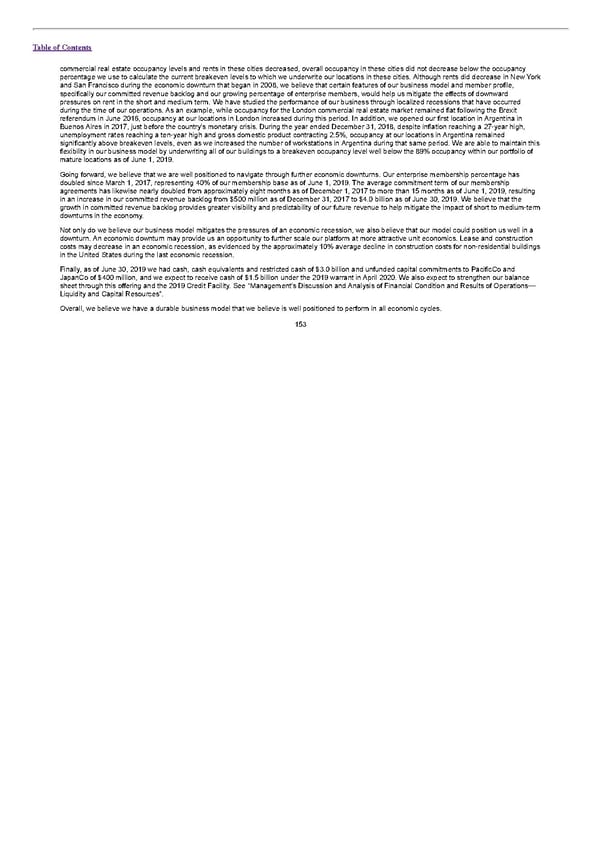Table of Contents commercial real estate occupancy levels and rents in these cities decreased, overall occupancy in these cities did not decrease below the occupancy percentage we use to calculate the current breakeven levels to which we underwrite our locations in these cities. Although rents did decrease in New York and San Francisco during the economic downturn that began in 2008, we believe that certain features of our business model and member profile, specifically our committed revenue backlog and our growing percentage of enterprise members, would help us mitigate the effects of downward pressures on rent in the short and medium term. We have studied the performance of our business through localized recessions that have occurred during the time of our operations. As an example, while occupancy for the London commercial real estate market remained flat following the Brexit referendum in June 2016, occupancy at our locations in London increased during this period. In addition, we opened our first location in Argentina in Buenos Aires in 2017, just before the country’s monetary crisis. During the year ended December 31, 2018, despite inflation reaching a 27-year high, unemployment rates reaching a ten-year high and gross domestic product contracting 2.5%, occupancy at our locations in Argentina remained significantly above breakeven levels, even as we increased the number of workstations in Argentina during that same period. We are able to maintain this flexibility in our business model by underwriting all of our buildings to a breakeven occupancy level well below the 89% occupancy within our portfolio of mature locations as of June 1, 2019. Going forward, we believe that we are well positioned to navigate through further economic downturns. Our enterprise membership percentage has doubled since March 1, 2017, representing 40% of our membership base as of June 1, 2019. The average commitment term of our membership agreements has likewise nearly doubled from approximately eight months as of December 1, 2017 to more than 15 months as of June 1, 2019, resulting in an increase in our committed revenue backlog from $500 million as of December 31, 2017 to $4.0 billion as of June 30, 2019. We believe that the growth in committed revenue backlog provides greater visibility and predictability of our future revenue to help mitigate the impact of short to medium-term downturns in the economy. Not only do we believe our business model mitigates the pressures of an economic recession, we also believe that our model could position us well in a downturn. An economic downturn may provide us an opportunity to further scale our platform at more attractive unit economics. Lease and construction costs may decrease in an economic recession, as evidenced by the approximately 10% average decline in construction costs for non-residential buildings in the United States during the last economic recession. Finally, as of June 30, 2019 we had cash, cash equivalents and restricted cash of $3.0 billion and unfunded capital commitments to PacificCo and JapanCo of $400 million, and we expect to receive cash of $1.5 billion under the 2019 warrant in April 2020. We also expect to strengthen our balance sheet through this offering and the 2019 Credit Facility. See “Management’s Discussion and Analysis of Financial Condition and Results of Operations— Liquidity and Capital Resources”. Overall, we believe we have a durable business model that we believe is well positioned to perform in all economic cycles. 153
 S1 - WeWork Prospectus Page 176 Page 178
S1 - WeWork Prospectus Page 176 Page 178